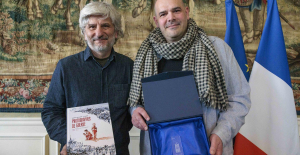An error set in stone. The Armenian resistance fighter Missak Manouchian, recently entered the Pantheon, was born in 1909, and not in 1906, as indicated by the stele of his tomb in the nave of the Pantheon. The latter was therefore executed by the Germans in February 1944 at the age of 34, and not 37.
A very recent discovery, in the light of a fortuitous crossing between the research work of the Manouchian family in Yerevan, and the exhibition in tribute to the resistance fighter, which takes place in the mysteries of the mausoleum in Paris.
It all starts in the Armenian capital. In May 2023, Katia Guiragossian, great-niece of Mélinée, Missak's partner, discovered during a visit to the Yerevan Museum of Art and Literature around ten notebooks written in Armenian by the resistance fighter. Hearing the news, historian Denis Peschanski, who directs the exhibition “Living to Die” honoring Missak and Mélinée at the same time as recounting the role of the Francs-Tireurs and Partisans of the Main- of Immigrant Work (FTP-MOI) in the Second World War, a group to which Missak belonged, asked to obtain these notebooks.
Three of them arrived in Paris on February 22, the day before the opening of the exhibition. Denis Peschanski places them open under a window. “We had just discovered the existence of these notebooks,” confesses the commissioner to Le Figaro. So the work of translating these pages, written in French and Armenian, had not yet been done.” A few minutes later, the Manouchian family arrived at the Pantheon to preview the exhibition.
Upon their arrival, the descendants of Missak Manouchian explained to the commissioner that an oral tradition passed down through the generations states that the resistance fighter aged three years to be able to go to work in France. In 1924, when Missak left his orphanage in Beirut to join his brother Garabed in France, he was 15 years old. Too young to be able to work, the resistance fighter pushed back his date of birth by arriving in France to work on a construction site in the South, at Seyne-sur-Mer. “I had never heard of this story,” admits Denis Peschansky.
Also read “We finally recognize the place of foreigners in the Resistance”: at the Pantheon, the vibrant tribute to the Manouchian couple
This story quickly turns out to be true: Louisa and Hasmik, great-grandnieces of the Armenian resistance fighter, lean into the window and decipher, fascinated, the few lines written in the diary in Armenian. “I do not remember a moment of peace in my life,” wrote the young stateless person, who had just arrived in Paris, in a translation reported by Le Monde. “I have always been in a struggle with myself. I am 25 years old and I would like to understand where this turbulent life will end. I would like to give myself up but it seems that a stone has been placed on my heart. Material and moral concerns follow one another. Where will this turbulent life take me? »
The calculation is quickly done. The page is written in February 1935, and the young writer claims to be 25 years old. The author has therefore aged by 3 years. In the 1920s, such a practice was common among immigrants who came to France in order to be of legal age to work. “At that time,” explains Denis Peschanski, “France had a considerable shortage of manpower at the end of the First World War and was hiring like crazy.”
At the same time, the Armenian context is particular: twenty years after the Armenian genocide which decimated a million people, many archives and birth certificates were destroyed after the desecration of Christian churches, which kept the birth certificates of the subjects Ottoman Armenians. Missak Manouchian therefore heads to France, modifying this date of birth along the way. “This story is that of many immigrants who arrived in France in the 1920s,” points out the exhibition curator who remembers a “very touching moment, a moving discovery.” “The Manouchian family actively participated in lifting the veil on the gray areas of Missak’s life.” For the specialist, this discovery “also refers to the youth of the combatants during the Second World War. When Manouchian was executed, he was barely 34 years old!”
Should we therefore re-engrave the Pantheon stele? “This false date is of no importance,” says the expert. “This error sheds additional light on the era in which Manouchian lived. We still have a lot to discover about him,” continues Denis Peschanski, who insists on the evolving nature of historical science. It was by chance that he learned of the two requests for French naturalization that the communist resistance fighter had made, during a discussion with an archivist just a few months earlier. “It’s all part of his legend,” smiles the commissioner. Pantheonizing someone each time offers the possibility of deepening historical research.”

 B:SM will break its investment record this year with 62 million euros
B:SM will break its investment record this year with 62 million euros War in Ukraine: when kyiv attacks Russia with inflatable balloons loaded with explosives
War in Ukraine: when kyiv attacks Russia with inflatable balloons loaded with explosives United States: divided on the question of presidential immunity, the Supreme Court offers respite to Trump
United States: divided on the question of presidential immunity, the Supreme Court offers respite to Trump Maurizio Molinari: “the Scurati affair, a European injury”
Maurizio Molinari: “the Scurati affair, a European injury” Irritable bowel syndrome: the effectiveness of low-carbohydrate diets is confirmed
Irritable bowel syndrome: the effectiveness of low-carbohydrate diets is confirmed Beware of the three main sources of poisoning in children
Beware of the three main sources of poisoning in children First three cases of “native” cholera confirmed in Mayotte
First three cases of “native” cholera confirmed in Mayotte Meningitis: compulsory vaccination for babies will be extended in 2025
Meningitis: compulsory vaccination for babies will be extended in 2025 In the United States, a Boeing 767 loses its emergency slide shortly after takeoff
In the United States, a Boeing 767 loses its emergency slide shortly after takeoff The A13 motorway will not reopen on May 1
The A13 motorway will not reopen on May 1 More than 1,500 items for less than 1 euro: the Dutch discounter Action opens a third store in Paris
More than 1,500 items for less than 1 euro: the Dutch discounter Action opens a third store in Paris 100 million euros in loans, water storage, Ecophyto plan… New measures from the executive towards farmers
100 million euros in loans, water storage, Ecophyto plan… New measures from the executive towards farmers Books poisoned with arsenic present in French libraries
Books poisoned with arsenic present in French libraries New York justice returns 30 works of art looted from Cambodia and Indonesia
New York justice returns 30 works of art looted from Cambodia and Indonesia Les Galons de la BD dedicates War Photographers, a virtuoso album on the Spanish War
Les Galons de la BD dedicates War Photographers, a virtuoso album on the Spanish War Theater: Kevin, or the example of an academic failure
Theater: Kevin, or the example of an academic failure Skoda Kodiaq 2024: a 'beast' plug-in hybrid SUV
Skoda Kodiaq 2024: a 'beast' plug-in hybrid SUV Tesla launches a new Model Y with 600 km of autonomy at a "more accessible price"
Tesla launches a new Model Y with 600 km of autonomy at a "more accessible price" The 10 best-selling cars in March 2024 in Spain: sales fall due to Easter
The 10 best-selling cars in March 2024 in Spain: sales fall due to Easter A private jet company buys more than 100 flying cars
A private jet company buys more than 100 flying cars This is how housing prices have changed in Spain in the last decade
This is how housing prices have changed in Spain in the last decade The home mortgage firm drops 10% in January and interest soars to 3.46%
The home mortgage firm drops 10% in January and interest soars to 3.46% The jewel of the Rocío de Nagüeles urbanization: a dream villa in Marbella
The jewel of the Rocío de Nagüeles urbanization: a dream villa in Marbella Rental prices grow by 7.3% in February: where does it go up and where does it go down?
Rental prices grow by 7.3% in February: where does it go up and where does it go down? Even on a mission for NATO, the Charles-de-Gaulle remains under French control, Lecornu responds to Mélenchon
Even on a mission for NATO, the Charles-de-Gaulle remains under French control, Lecornu responds to Mélenchon “Deadly Europe”, “economic decline”, immigration… What to remember from Emmanuel Macron’s speech at the Sorbonne
“Deadly Europe”, “economic decline”, immigration… What to remember from Emmanuel Macron’s speech at the Sorbonne Sale of Biogaran: The Republicans write to Emmanuel Macron
Sale of Biogaran: The Republicans write to Emmanuel Macron Europeans: “All those who claim that we don’t need Europe are liars”, criticizes Bayrou
Europeans: “All those who claim that we don’t need Europe are liars”, criticizes Bayrou These French cities that will boycott the World Cup in Qatar
These French cities that will boycott the World Cup in Qatar PSG: “Immense pride in continuing the adventure in Paris”, relishes Zaire-Emery
PSG: “Immense pride in continuing the adventure in Paris”, relishes Zaire-Emery Breaking: everything you need to know about this sport
Breaking: everything you need to know about this sport NBA: Lakers gain respite, Boston responds to Miami
NBA: Lakers gain respite, Boston responds to Miami Top 14: “a very severe red card”, estimates Labit (French Stadium)
Top 14: “a very severe red card”, estimates Labit (French Stadium)

















